Chapter 10
Mechanical Systems and Ductwork
Ductwork, like pipework, is a system family through which the Autodesk® Revit® MEP platform can calculate airflow rates and pressure drops on any correctly defined system. Ductwork also provides the graphics for the traditional “drawn” documentation and the variety of ways this can be represented on a drawing sheet at different stages of a project, regardless of whether the duct is presented as a single line at concept design or as a fully-coordinated double line for a construction issue.
The three main types of duct are rectangular, round, and oval. These three types are the basis for your design and documentation. There are two ways of using ducts, either with the Duct tool or the Placeholder Duct tool. Placeholders were introduced in the 2012 version for ducts and pipes, and allow the designer to rough in layouts in single line.
Although at first glance this seems similar to a view displaying at a coarse level of detail, the placeholders display only a single line, regardless of the level of detail that is set. In addition, placeholders do not create fittings when a duct run is drawn, although they do show a symbolic representation where rise/drops occur. However, they still have the use of all the design tools that an engineer requires, allowing the duct to be sized based on airflow, elevation, and so on. All these duct types, whether placeholder or normal, connect to air terminals and a variety of mechanical equipment. They also host duct fittings and accessories. By using the fittings and accessories available with the standard installation, the user can create supply, return, and exhaust systems with very little additional thought.
During your implementation, however, you should also consider the benefits of creating additional duct types that suit the way you work and your company's standards.
In this chapter, you will learn to do the following:
- Distinguish between hosted and nonhosted components
- Convert placeholder ducts into ducts with fittings
- Use the different duct routing options
- Adjust duct fittings
Air Distribution Components
Air distribution components come in many shapes and sizes. Depending on the design, they can be mounted in a variety of ways, such as the following:
- Diffusers in a ceiling
- Duct-mounted sidewall diffusers
- Wall mounted
- Suspended
In each of these instances, the designer must decide whether to use hosted components (and if so, which type of hosting) or whether to host at all. There are different (and similar) ways of placing these objects, and some may be conflicting.
An example of this is an installation that has diffusers hosted in the ceiling, as well as areas where the architect's design is for suspended fittings (see Figure 10.1). In this project, assume that there is an external architect and that the architectural model is being linked. This means straightaway that you cannot use ceiling-hosted air terminals. Although you can see the linked ceiling, Revit recognizes it only as a face. Because of this, the air terminals will need to be created either as face-hosted families or families that are hosted to the level—that is, no physical hosting.
Figure 10.1 Diffuser hosting methods
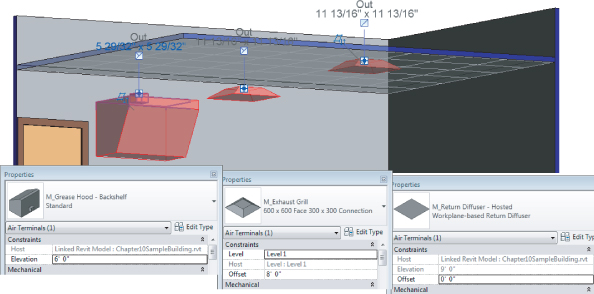
The most important point here is that, after you commit to one type of family (hosted, nonhosted, wall, and so on), you can exchange, for example, a ceiling-hosted air terminal only with a similarly-hosted air terminal not just those that are of the same category (see Figure 10.2).
Figure 10.2 Hosting error message
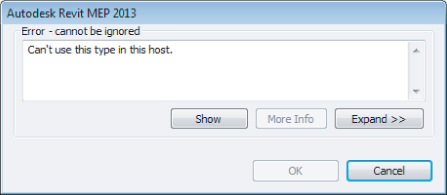
The next problem is that the air terminals that are suspended are in fact the same type as those that are mounted within the ceiling tiles. The engineer wants to be able to schedule and filter them as one. How do you manage this?
The ability to copy/monitor air terminals (as well as lighting fixtures, mechanical equipment, and plumbing fixtures) means that the services engineers can monitor the locations of air terminals that the architect has placed because the architect is responsible for placing these objects. As with the other items that can be copied/monitored, the services designer can choose to copy the original family type from the linked file or “map” it to one of their own choosing. In Figure 10.3, you can see, however, that after the air terminals have been copied/monitored, regardless of the type of host association, this ceiling-hosted family has no host but is in the correct location specified by the architect.
Figure 10.3 Copy/monitor nonhosting

Mechanical Equipment Components
Mechanical equipment comprises the components that make up the majority of large- to medium-size plant objects for the mechanical designer. From air conditioners (ACs) and air-handling units (AHUs) to air curtains and heat pumps, these all provide the geometry and parameters associated with HVAC design. As with all components, choosing the hosting type is important. A level-hosted object cannot be exchanged for a face-hosted or ceiling-hosted one.
Air Conditioning/Handling Units
The heart of the mechanical air system, air conditioning/handling units, can start life as generic “boxes” with intake and exhaust. Although basic in construction and with no manufacturer data attached, generic ACs/AHUs can have the same number of parameters as more-detailed families. Similar in dimension and performance, the concept box can be swapped out during the detail design period for a more detailed manufacturer or “construction-issue” family, or even for a set of families if the AC/AHU unit has been constructed from its manufacturer's component parts (see Figure 10.4).
Figure 10.4 Basic AHU and type parameters

The majority of ACs/AHUs are generally placed on the level where they are inserted, with no offset. This placement can depend on whether the unit is mounted on rails and whether those rails are part of the AC/AHU family (see Figure 10.5).
Figure 10.5 Floor-mounted and skid-mounted AC/AHU

Floor Mounted
Skid Mounted
- The family can be created in the same manner as the previous example, which allows for an offset to be applied. This allows for the structural engineer to locate elements in their file. Then subsequent placement of the mechanical plant is done in the MEP file.
- Alternatively, the Mechanical Equipment family can have the structural elements built in, allowing the MEP designer to place the unit—including the rails—directly on the slab.
VAV Boxes
Generally created as nonhosted families, variable air volume (VAV) terminal boxes are usually mounted somewhere within the ceiling void, suspended from the underside of the slab above. In terms of placement, these are given an offset. Using the Properties palette, the offset can be predefined prior to the VAV being placed in this case. This makes for an easier workflow than in previous releases, in which most objects were placed on the reference level and then subsequently moved to the correct invert level (see Figure 10.6).
Figure 10.6 Changing the invert level

Connections to both AC units and VAV boxes can include heated- and chilled-water services, and electrical for connecting to water and electrical systems (see Figure 10.7). Also note the new connector labels in this view, which allow easier identification of connections and their flow direction (where applicable).
Figure 10.7 Typical mechanical and electrical connections to mechanical equipment
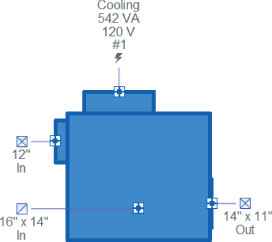
Ductwork
Ducts can be displayed in a variety of ways, including rectangular, round, oval, or placeholder, as shown in Figure 10.8.
Figure 10.8 Ductwork
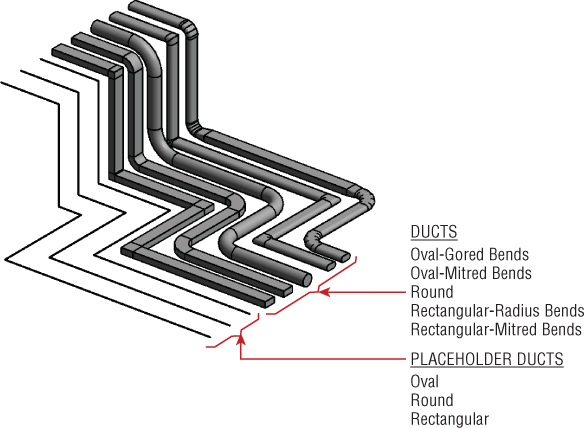
Placeholder ducts, as you can see in Figure 10.8, are shown only as a single line, although they retain nearly all the characteristics and properties of a regular duct. In Figure 10.9, you can see the differences. Placeholder ducts do not have values for Justification, Insulation, or Lining, because they are not needed at the conceptual stage of the project when placeholders are being used.
Figure 10.9 Design criteria for placeholder ducts
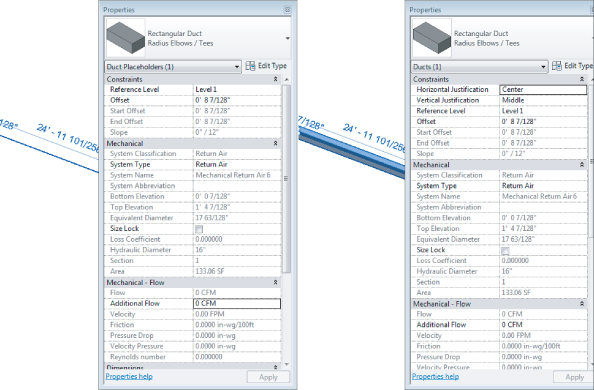
The Duct tool is a system family, and it is the glue that holds systems together. However, it also relies on standard families to create a duct type, as described in the next section. Although ducts hold a huge amount of information, for the user there are several important considerations to note.
As you saw in Chapter 8, “HVAC Cooling and Heating Load Analysis,” Revit MEP 2013 provides significant enhancements to systems, including the ability to specify the type of system that a duct is associated with (Exhaust, Return, or Supply), without actually being connected to any equipment, as shown in Figure 10.10.
Figure 10.10 Ducts associated with systems

When highlighted in the System Browser, both ducts and placeholder ducts are highlighted in the drawing area. If a duct is created in the wrong system type, simply select one section of the run and change it to the required system. All the connected ducts and fittings will also change. This ability can have several benefits, among which are these:
- The user doesn't have to remember to select the appropriate system before creating a duct—its system type can be changed at any time.
- Differing systems can be connected together. An example of this for ducts could be a supply AHU with a redundant backup. Although the backup system will not be included in the system calculations, it can connect to the main supply without affecting the calculations in that system.
In Revit MEP 2013, all systems are named. Even though they may be default names, it is easy to change them on the fly.
Interference checking in Revit MEP 2013 is a comprehensive and accurate tool. Not only can you use the placeholder ducts (and pipes) in the interference check, but Duct Insulation can be also be included as part of the process (see Figure 10.11).
Figure 10.11 Interference check
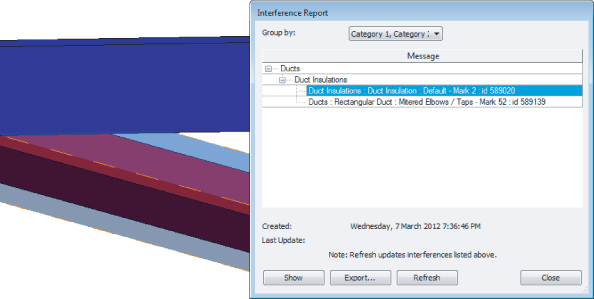
Duct Types and Routing
Creating new duct types is a way of managing how your runs of duct work and connect into each other, such as whether bends are mitered or radiused. Although you can change any of the fittings inserted retrospectively, it is much easier to create a run in one go, using either the automatic or manual tools.
Creating New Duct Types
Although it may be tempting to create types such as Extract and Supply, try to keep these names more specific, such as Stainless-2D Radius/Taps or Galvanized-Mitered/Tees. This way, the user has to think about only what material the duct is constructed of. Although using a name that specifies Supply or Extract may be initially attractive, doing so can lead to ambiguity and misunderstandings among the modeler, designer, engineer, and potentially the client. Another downside to this is the need to create multiple types of bends, tees, crosses, and so on for all the different material types and system types you are likely to use.
To create additional duct types or to edit existing types, right-click one of the existing types in the Project Browser. To create a new type, click Duplicate. This will copy an existing duct type and append the number 2 to the end of the name (for example, Mitered Elbows/Tees 2). Right-click again to access the Type Properties. At this point, you can choose to rename the duct type and supply the necessary fittings. These fittings will need to be preloaded to use, but you can also reuse those already in use in the project/template.
Using Automatic Duct Routing
When using the automatic routing tools, as a rule of thumb you should work on small sections—all the feeds to a VAV box is one good example. This means the computer has fewer objects to calculate, and the routing suggestions have less room for error. Before even starting this process, check the options under Mechanical Settings (see Figure 10.12) for default Duct Type, Offset, and Maximum Flex Duct Length because these are used during the routing process. Also note that these settings can be set for the different system types.
Figure 10.12 Mechanical Settings
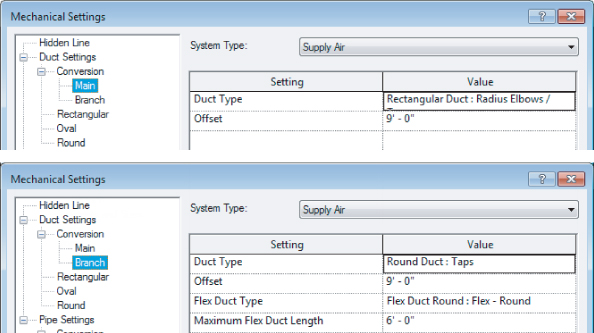
Now you're ready to use automatic duct routing. Here's how:
- What type are the ceilings (if any)?
- If there are ceilings, should you use face, ceiling, or nonhosted families?
- Are you going to create your own placeholder ceiling to host your families?
- Should you use the new ability to copy/monitor the air terminals already placed by the architect?
- Choose the type of air terminal. Is it top, side, or even sidewall entry?
Figure 10.13 Space properties
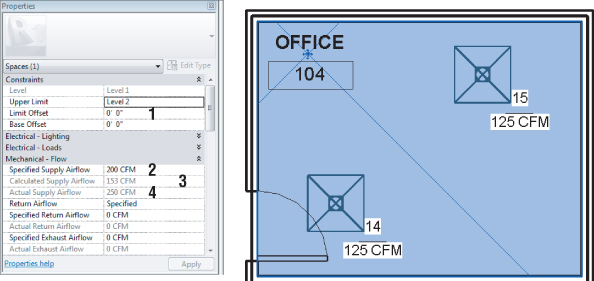
Figure 10.14 Create Systems panel
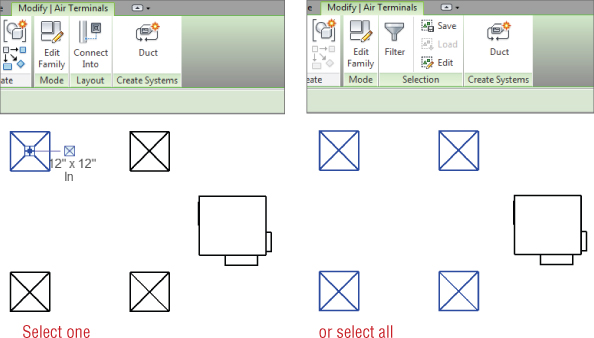
Figure 10.15 Create Duct System dialog box

Figure 10.16 Add To System command
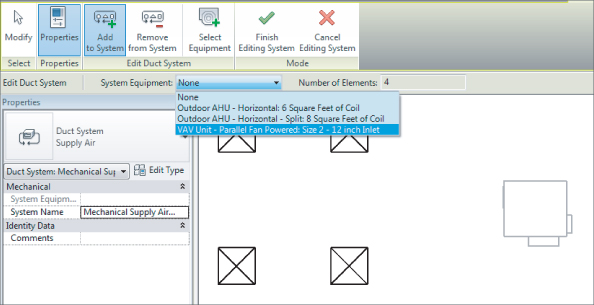
Figure 10.17 Tab-selecting the system
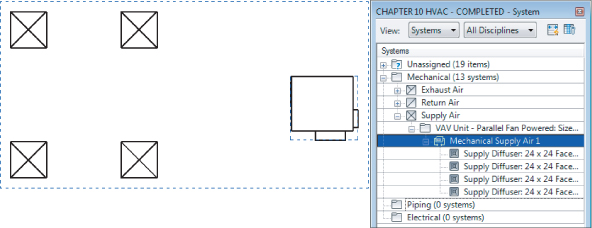
Figure 10.18 Generating a layout
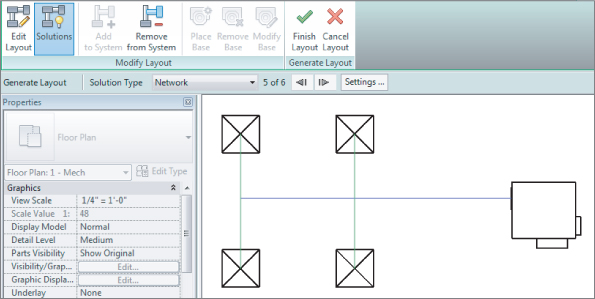
Figure 10.19 Ductwork routing solutions
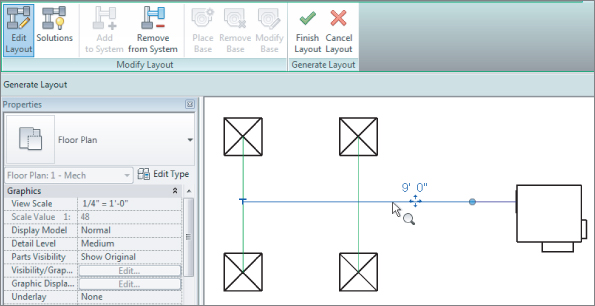
Figure 10.20 Completed duct layout
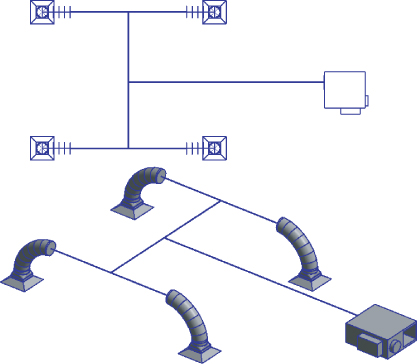
It's worth pointing out here that the sizes used for this layout are based on the connection sizes and the settings for duct sizes located in the Mechanical Settings dialog box. There is another important consideration at this point. The designer/drafter must ensure that the default settings for the main and branch ducts are adequately high enough above the air terminals and associated equipment to generate the layout; otherwise, the layout tool will not be able to generate a layout, even if the layout is created with placeholder ducts. This can be achieved in two ways: either by selecting the Settings button on the Options bar (shown in Figure 10.18) or by selecting the actual sketch lines of the solution, which allow the user to manually choose the offset.
Using Manual Duct Routing
For the experienced design drafter, using the automatic tools may seem too limiting. However, with experience and use, most users eventually settle for a variety, sometimes for no better reason than “a change is as good as a rest.” Sometimes, however, the manual tool is much more efficient, especially when connecting different areas into a system or laying out runs back to a rooftop AHU.
To begin manual duct routing, do the following:
Figure 10.21 Duct types
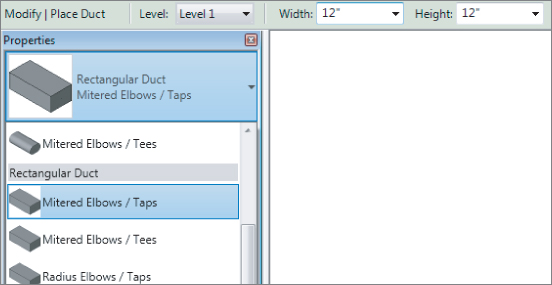
Figure 10.22 Duct settings
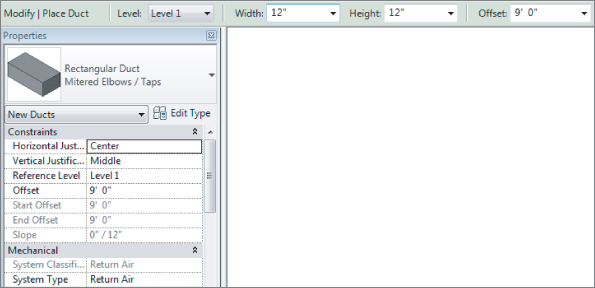

Figure 10.23 Editing duct in sections

Figure 10.24 Completing the set-down

When creating ducts that set down/up or drop/rise, it can be much easier to model these in a section or elevation view, as shown in Figure 10.23 and Figure 10.24. To do this, first you need to create a suitable view. Quite often, individuals have a personal section that they move around the model. It can be opened when required, and then the duct (or whatever service is being worked on) is modified and the view is closed.
Adjusting Fittings and Extending the Design
Changing the justification of ducts is a relatively easy task, but it really needs some practice to actually master. Selecting a duct or a run of ducts/fittings gives the user the option to change justification. Select your duct run, and from the Modify tab, select Justify.
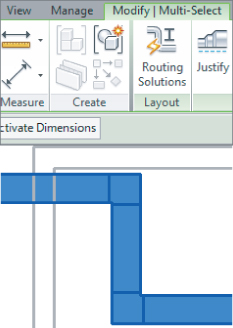
This opens the Justification Editor, as shown in Figure 10.25. Here, the control point can be displayed, and the alignment along the selected route can be selected by using the Alignment Line button. You can choose justification by using one of the nine Justification control buttons. This can have significant effects on your layout, so it is best to use this tool in small, easy-to-view sections or 3D views.
Figure 10.25 Duct Justification Editor
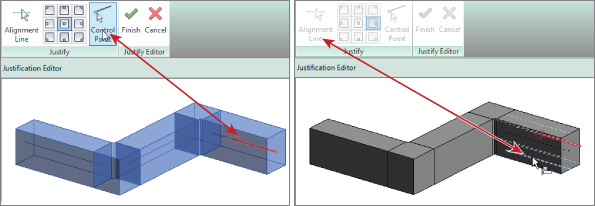
It is worth making the point here that duct justification is not available for duct placeholders.
You can also change the type of an entire duct run from one type of duct to another. In previous versions, this involved multiple selections and filters. Now all the user has to do is to select the duct run, as you can see in Figure 10.26. Here, the duct system has been selected, and the only proviso is that flexible ducts, air terminals, and mechanical equipment are not in the selection set.
Figure 10.26 Changing the duct type
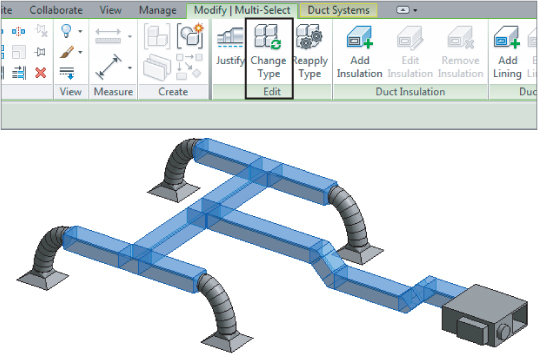
This is a logical step, because the ducts and duct fittings in the selection set are usually also defined within the duct type. Therefore, when you select the objects and click the Change Type button, you are presented with a condensed Properties box that allows you to change the run type for others already in use in the project (see Figure 10.27).
Figure 10.27 The changed duct type
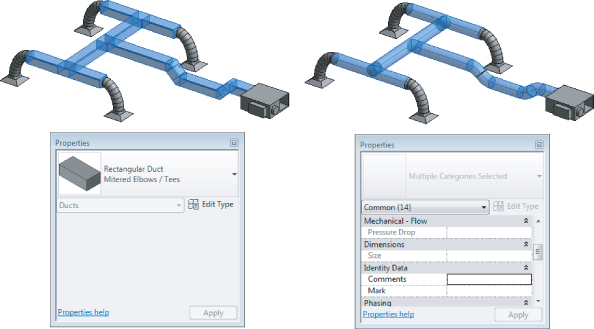
In this next example, the design has gone through a few iterations, and changes have been made to various fittings and portions of the duct run. New to Revit MEP 2013 is the Reapply Type option. Selecting the entire run allows the user to reapply the original duct types to the objects selected, as shown in Figure 10.28.
Figure 10.28 Reapply duct type

The direction of flow and graphical warnings are really helpful for the designer. The direction of flow is a temporary display when you select any object that has a mechanical or piping connection. This is a great benefit for designers and drafters, because they can visualize which way air (or gas or water) is flowing through an object. As you can see in Figure 10.29, the selected VAV box has two supply ducts: one entering from the right and the other exiting from the left. There is also a return-air and electrical connection.
Figure 10.29 Flow connectors
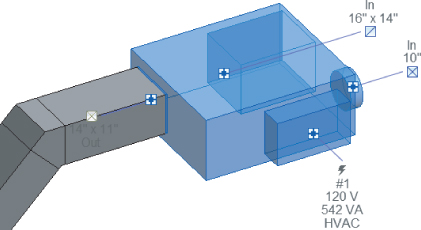
Warnings related to MEP connections can be displayed as graphical notifications when there is a disconnect in the system. You can change the warnings to suit your current task from the Analyze tab. Select the Show Disconnects button and then select the options you require, as shown in Figure 10.30.
Figure 10.30 Show Disconnects Options

To extend an existing layout, as indicated in Figure 10.31, select one of the fittings (typically a bend or tee). You will notice a small plus sign (+) adjacent to the side of the fitting that does not have a connector. Clicking this will turn a bend into a tee and a tee into a cross, eliminating the need to delete a fitting and insert an appropriate one.
Figure 10.31 Extending the design
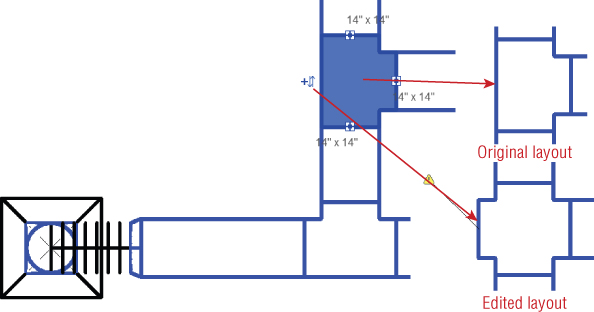
Duct Sizing
The most important factors to consider when using the Duct Sizing tools are that the ducts form part of a system and that this system should have a nominated name that suits your design (not a default), which is created at the same time as the system being created. The system must also have a valid airflow, so either you specify the airflow of the air terminals or that flow is specified from the space and volume calculations.
Use the Tab key to select your system, as shown in Figure 10.32.
Figure 10.32 Tab-selecting the system and Duct Sizing tool
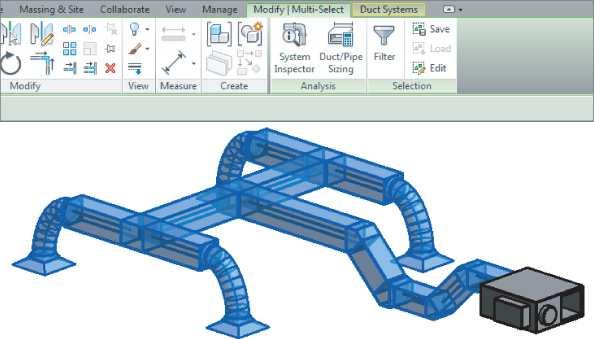
The Duct/Pipe Sizing tool is located on the Modify | Multi-Select tab of the ribbon. This button becomes active when you select a single duct or duct run that is part of a fully-enclosed system, whose components are connected properly in regard to flow direction. Clicking the button opens the Duct Sizing dialog box. Figure 10.33 shows its available options.
Figure 10.33 Duct Sizing dialog box
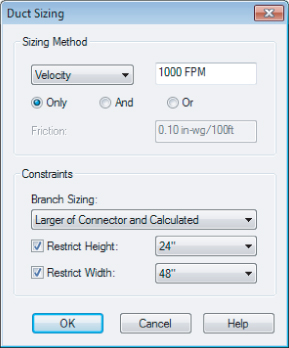
Choosing a Duct Sizing Method
Although the sizing method you choose can be applied to an entire system, this is not necessarily the most efficient way to do things. If there are 5,257 objects in your system, it's probably not a great idea to ask your computer to process that amount of information—it may take a while! The logical choice is to split the task of duct sizing into manageable sections, such as a floor plan, a zone, or a group of air terminals fed from the same VAV box.
The various methods for sizing are as follows:
- Friction
- Velocity
- Equal Friction
- Static Regain
Friction and Velocity can be used independently of each other when using the Only option. Alternatively, they can be used in conjunction with each other with the And and Or functions.
These options allow the designer to force the sizing ducts to meet the parameters specified for both Velocity and Friction. With the Or method, the least restrictive of either of the parameters is used.
The Equal Friction and Static Regain methods use the ASHRAE Duct Fitting Database.
Air properties are set in the Mechanical Settings dialog box, as are the available sizes of ducts used in the actual sizing calculations (see Figure 10.34 and Figure 10.35).
Figure 10.34 Mechanical Settings dialog box, Duct Settings
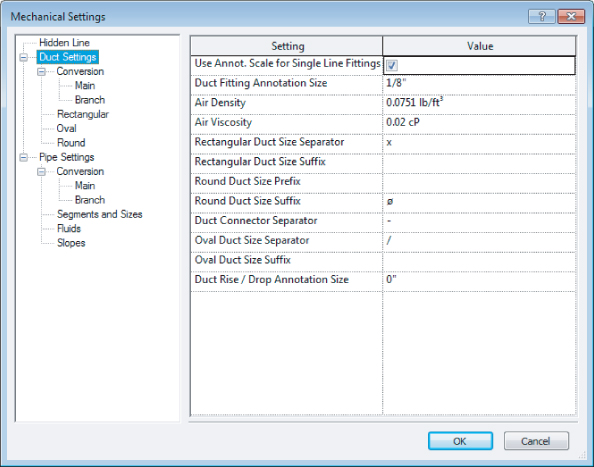
Figure 10.35 Mechanical Settings dialog box, duct sizes
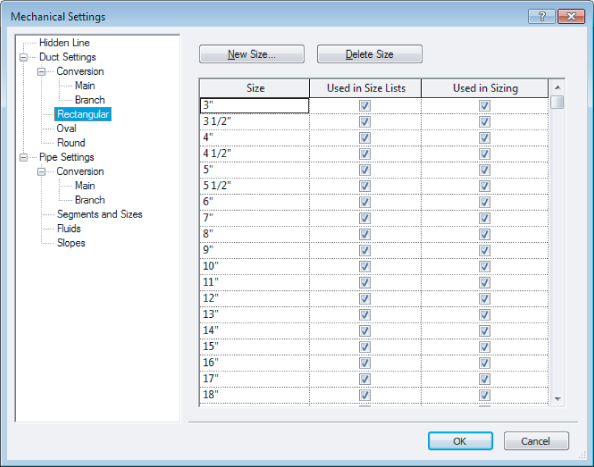
During the sizing process, you can also apply constraints to the branch parts of the run. These are defined as Calculated Size Only, Match Connector Size, and Larger Of Connector And Calculated (see Figure 10.36). Depending on the stage of the design or your actual role (such as consultant), you could choose Calculated Size Only, because the design is still in its early stages and the equipment is generic. These settings allow you to coordinate with other model components in areas where space is limited. For example, if you have only 2′–0″ (600 mm) of space above the ceiling, you could restrict the height of your duct to 20″ (500 mm).
Figure 10.36 Duct sizing Constraints
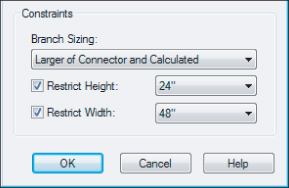
However, later in the project when the equipment has been specified, as a contractor you may want to select Match Connector Size and Larger Of Connector And Calculated to reduce the number of duct sizes used on the project, thereby reducing your manufacturing costs.
This dialog box also allows you to specify a limit on the size of the ducts, which can further reduce costs or give you the ability to specify, say, a continuous duct height in places where you know access is a potential issue.
To add insulation and lining to a selection set that contains both ducts and duct fittings, simply create your selection set and choose the appropriate option, as shown in Figure 10.37.
Figure 10.37 Insulation and lining tools

Lining and insulation can have overrides or filters applied so that they display in the required manner, even to the extent of showing insulation as transparent with a hidden line style, as indicated in Figure 10.38.
Figure 10.38 Insulation and lining graphic overrides
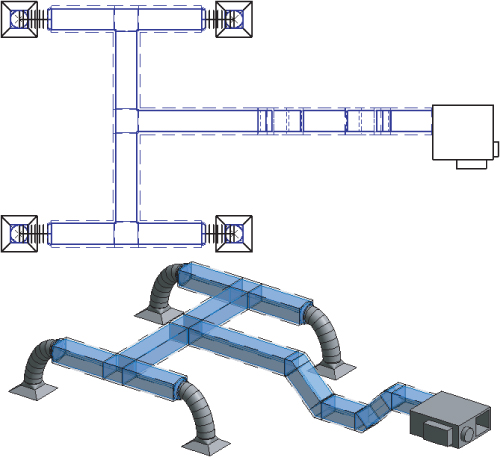
Although lining and insulation can be added only as instance parameters, the workflow for using this tool is much easier than in most previous releases. Even so, if the entire system requires lined or insulated duct, the user will have to select all ducts for the system and then specify the insulation or lining required.
Duct sizing will work only where air terminals, ducts, duct fittings, and mechanical equipment are seamlessly connected with no gaps and where the equipment has a defined airflow. This airflow could be entered as part of the initial analysis or subsequent manipulation of the objects.
Once a system has been created, you can use the analytical tools to inspect the duct system for airflow, pressure, and pressure loss. From the System Browser, select the system you want to analyze (as shown in Figure 10.39). Remember, you can also Tab-select the system. With the system selected, click System Inspector on the ribbon.
Figure 10.39 Selecting a system
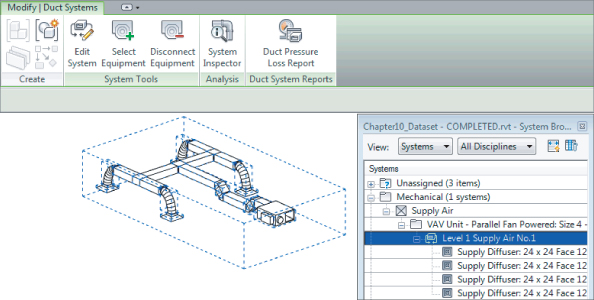
This activates the System Inspector tool, as shown in Figure 10.40. Click System Inspector again and pass your cursor over the elements in the system; notice that airflow and pressure loss are defined.
Figure 10.40 System Inspector
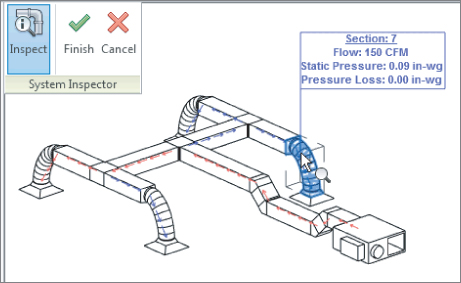
As with all calculations, you may want to keep a record of this analysis as part of you project documentation. New to Revit MEP 2013 is the ability to create a Duct (or Pipe) Pressure Loss Report. This tool is located on the Analyze tab or on the Modify | Duct Systems tab, as shown in Figure 10.39. Here you have a choice: either select the system first, or specify the system you want to create the report on in the Analyze tab. Once the system is selected, the dialog box shown in Figure 10.41 is displayed. In this dialog, you can specify the fields to use and save the report format for later use. Clicking Generate will create an HTML web page of your results.
Figure 10.41 Duct Pressure Loss Report Settings

Using the Duct Routing Tools
Now that you have reviewed the process of using the Duct Routing tools, you will learn how to apply them in a simple exercise:
Figure 10.42 Plan view

- Main duct: Rectangular Duct: Mitered Elbows/Tees
- Offset: 11′–0″ (3300 mm)
- Branch duct: Rectangular Duct: Mitered Elbows/Tees
- Offset: 11′–0″ (3300 mm)
- Flexible duct: Flex Duct Round: Flex - Round with a maximum length of 6′–0″ (1800 mm)
Figure 10.43 Default 3D view with flex errors

Figure 10.44 Moving transitions
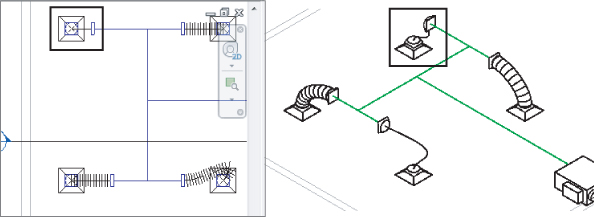
Figure 10.45 Duct Placeholders
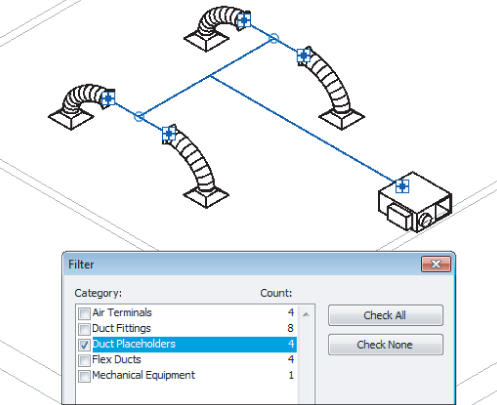
Figure 10.46 Converted duct placeholders
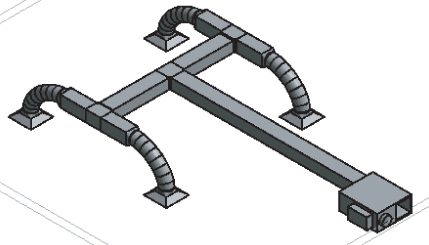
Figure 10.47 Split duct

The Bottom Line
Distinguish between hosted and nonhosted components.
Deciding whether hosted or nonhosted components are used is crucial for the success of your project. This decision will play a large factor in performance and coordination with other companies.
Master It
Should you choose hosted or nonhosted components for your project?
Convert placeholder ducts into ducts with fittings.
Master It
Use the different duct routing options.
When using Revit MEP 2013 for your duct layouts, the user must understand the functions of automatic duct routing and manual duct routing. Once these functions are mastered, the user can lay out any type of ductwork system.
Master It
When asked to submit a design proposal for a multifloor office building, the HVAC designer needs to show a typical open-plan office and the supply and extract ductwork. How should the designer start this process?
Adjust duct fittings.
Duct fittings are needed in systems to make the systems function properly and to produce documentation for construction. Being able to add or modify fittings can increase productivity.
Master It
You have just finished your modeled layout and given it to your employer for review. Your boss asks you to remove a couple of elbows and replace them with tees for future expansion. What method would you use to accomplish this quickly?
